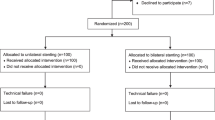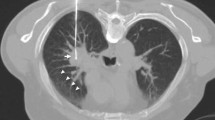Abstract
Objectives
To assess the relative diagnostic utility of low- and standard-dose computed tomography (CT)–guided lung biopsy.
Methods
In this single-center, single-blind, prospective, randomized controlled trial, patients were enrolled between November 2016 and June 2017. Enrolled study participants were randomly selected to undergo either low- or standard-dose CT-guided lung biopsy. Diagnostic accuracy was the primary study endpoint, whereas technical success, radiation dose, and associated complications were secondary study endpoints.
Results
In total, 280 patients underwent study enrollment and randomization, with 271 (low-dose group, 135; standard-dose group, 136) receiving the assigned interventions. Both groups had a 100% technical success rate for CT-guided lung biopsy, and complication rates were similar between groups (p > 0.05). The mean dose-length product (36.0 ± 14.1 mGy cm vs. 361.8 ± 108.0 mGy cm, p < 0.001) and effective dose (0.5 ± 0.2 mSv vs. 5.1 ± 1.5 mSv, p < 0.001) were significantly reduced in the low-dose group participants. Sensitivity, specificity, and overall diagnostic accuracy rates in the low-dose group were 91.8%, 100%, and 94.6%, respectively, whereas in the standard-dose group, the corresponding values were 89.6%, 100%, and 92.4%, respectively. These results indicated that diagnostic performance did not differ significantly between the 2 groups. Using univariate and multivariate analyses, we found larger lesion size (p = 0.038) and procedure-related pneumothorax (p = 0.033) to both be independent predictors of diagnostic failure.
Conclusions
Our results demonstrate that low-dose CT-guided lung biopsy can yield comparable diagnostic accuracy to standard-dose CT guidance, while significantly reducing the radiation dose delivered to patients.
Trial registration: ClinicalTrials.gov NCT02971176
Key Points
• Low-dose CT-guided lung biopsy is a safe and simple method for diagnosis of lung lesions.
• Low-dose CT-guided lung biopsy can yield comparable diagnostic accuracy to standard-dose CT guidance.
• Low-dose CT-guided lung biopsy can achieve a 90% reduction in radiation exposure when compared with standard-dose CT guidance.



Similar content being viewed by others
Abbreviations
- BMI:
-
Body mass index
- CI:
-
Confidence interval
- CT:
-
Computed tomography
- DLP:
-
Dose-length product
- ITT:
-
Intention-to-treat
- PET:
-
Positron emission tomography
- PP:
-
Per-protocol
- RCT:
-
Randomized controlled trial
References
Johnson JN, Hornik CP, Li JS et al (2014) Cumulative radiation exposure and cancer risk estimation in children with heart disease. Circulation 130:161–167
Fazel R, Krumholz HM, Wang Y et al (2009) Exposure to low-dose ionizing radiation from medical imaging procedures. N Engl J Med 361:849–857
Mettler FA Jr, Huda W, Yoshizumi TT, Mahesh M (2008) Effective doses in radiology and diagnostic nuclear medicine: a catalog. Radiology 248:254–263
Kaneko M, Eguchi K, Ohmatsu H et al (1996) Peripheral lung cancer: screening and detection with low-dose spiral CT versus radiography. Radiology 201:798–802
Henschke CI, McCauley DI, Yankelevitz DF et al (1999) Early lung Cancer action project: overall design and findings from baseline screening. Lancet 354:99–105
National Lung Screening Trial Research Team, Aberle DR, Adams AM et al (2011) Reduced lung-cancer mortality with low-dose computed tomographic screening. N Engl J Med 365:395–409
Infante M, Cavuto S, Lutman FR et al (2015) Long-term follow-up results of the DANTE trial, a randomized study of lung cancer screening with spiral computed tomography. Am J Respir Crit Care Med 191:1166–1175
Zheng M, Wu Y, Wei M, Liu Y, Zhao H, Li J (2015) Lowconcentration contrast medium for 128-slice dual-source CT coronary angiography at a very low radiation dose using prospectively ECG-triggered high-pitch spiral acquisition. Acad Radiol 22:195–202
Zheng M, Liu Y, Wei M et al (2014) Low concentration contrast medium for dual-source computed tomography coronary angiography by a combination of iterative reconstruction and low-tubevoltage technique: feasibility study. Eur J Radiol 83:e92–e99
Wang T, GongY SY, Hua R, Zhang Q (2017) Feasibility of duallow scheme combined with iterative reconstruction technique in acute cerebral infarction volume CTwhole brain perfusion imaging. Exp Ther Med 14:163–168
Chen GZ, Zhang LJ, Schoepf UJ et al (2015) Radiation dose and image quality of 70 kVp cerebral CT angiography with optimized sinogram-affirmed iterative reconstruction: comparison with 120 kVp cerebral CT angiography. Eur Radiol 25:1453–1463
Kim GR, Hur J, Lee SM et al (2011) CT fluoroscopy-guided lung biopsy versus conventional CT-guided lung biopsy: a prospective controlled study to assess radiation doses and diagnostic performance. Eur Radiol 21:232–239
Sangha BS, Hague CJ, Jessup J et al (2016) Transthoracic computed tomography–guided lung nodule biopsy: comparison of core needle and fine needle aspiration techniques. Can Assoc Radiol J 67:284–289
Ocak S, Duplaquet F, Jamart J et al (2016) Diagnostic accuracy and safety of CT-guided percutaneous transthoracic needle biopsies: 14-gauge versus 22-gauge needles. J Vasc Interv Radiol 27:674–681
Tai R, Dunne RM, Trotman-Dickenson B et al (2016) Frequency and severity of pulmonary hemorrhage in patients undergoing percutaneous CT-guided transthoracic lung biopsy: single-institution experience of 1175 cases. Radiology 279:287–296
Helck A, Schumann C, Aumann J et al (2016) Automatic path proposal computation for CT-guided percutaneous liver biopsy. Int J Comput Assist Radiol Surg 11:2199–2205
Shpilberg KA, Delman BN, Tanenbaum LN et al (2014) Radiation dose reduction in CT-guided spine biopsies does not reduce diagnostic yield. AJNR Am J Neuroradiol 35:2243–2247
Meng XX, Kuai XP, Dong WH et al (2013) Comparison of lung lesion biopsies between low-dose CT-guided and conventional CTguided techniques. Acta Radiol 54:909–915
Lee HN, Lee SM, Choe J et al (2018) Diagnostic performance of CT-guided percutaneous transthoracic core needle biopsy using low tube voltage (100 kVp): comparison with conventional tube voltage (120 kVp). Acta Radiol 59:425–433
Kallianos KG, Elicker BM, Henry TS et al (2016) Instituting a lowdose CT-guided lung biopsy protocol. Acad Radiol 23:1130–1136
Adiga S, Athreya S (2014) Safety, efficacy, and feasibility of an ultra-low dose radiation protocol for CT-guided percutaneous needle biopsy of pulmonary lesions: initial experience. Clin Radiol 69:709–714
Ettinger DS, Wood DE, Akerley W et al (2015) Non-small cell lung cancer, Version 6.2015. J Natl Compr Cancer Netw 13:515–524
Kim JI, Park CM, Kim H et al (2017) Non-specific benign pathological results on transthoracic core-needle biopsy: how to differentiate false-negatives? Eur Radiol 27:3888–3895
Tian P, Wang Y, Li L et al (2017) CT-guided transthoracic core needle biopsy for small pulmonary lesions: diagnostic performance and adequacy for molecular testing. J Thorac Dis 9:333–343
Yeow KM, Tsay PK, Cheung YC et al (2003) Factors affecting diagnostic accuracy of CT-guided coaxial cutting needle lung biopsy: retrospective analysis of 631 procedures. J Vasc Interv Radiol 14:581–588
Liu S, Li C, Yu X et al (2015) Diagnostic accuracy of MRI-guided percutaneous transthoracic needle biopsy of solitary pulmonary nodules. Cardiovasc Intervent Radiol 38:416–421
Lü Y, Fritz J, Li C et al (2013) Magnetic resonance imaging-guided percutaneous biopsy ofmediastinalmasses: diagnostic performance and safety. Investig Radiol 48:452–457
Funding
The authors state that this work has not received any funding.
Author information
Authors and Affiliations
Corresponding author
Ethics declarations
Guarantor
The scientific guarantor of this publication is Qing-Song Xu.
Conflict of interest
The authors declare that they have no conflict of interest.
Statistics and biometry
No complex statistical methods were necessary for this paper.
Informed consent
Written informed consent was obtained from all patients in this study.
Ethical approval
Institutional Review Board approval was obtained.
Methodology
• prospective
• randomized controlled trial
• performed at one institution
Additional information
Publisher’s note
Springer Nature remains neutral with regard to jurisdictional claims in published maps and institutional affiliations.
Rights and permissions
About this article
Cite this article
Fu, YF., Li, GC., Xu, QS. et al. Computed tomography–guided lung biopsy: a randomized controlled trial of low-dose versus standard-dose protocol. Eur Radiol 30, 1584–1592 (2020). https://doi.org/10.1007/s00330-019-06464-6
Received:
Revised:
Accepted:
Published:
Issue Date:
DOI: https://doi.org/10.1007/s00330-019-06464-6




